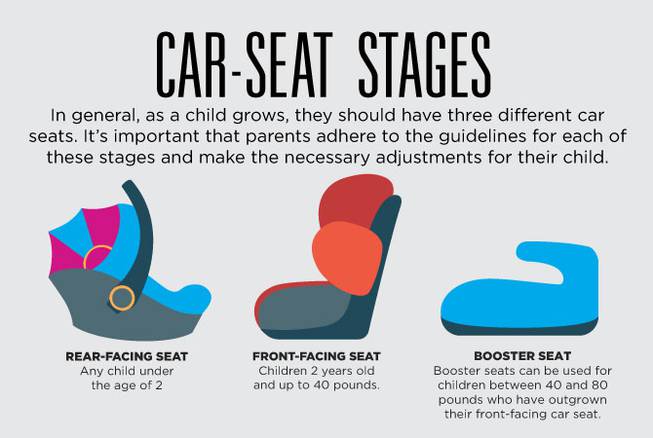
Monday, Sept. 19, 2016 | 2 a.m.
Car seats can reduce the risk of death for infants and toddlers by as much as 71 percent when used properly; unfortunately, 73 percent of car seats across the country are used or installed incorrectly, according to Safe Kids Worldwide, an organization dedicated to preventing injuries in children.
While the importance of car seats is inarguable, improper use and installation can greatly decrease their effectiveness and leave our littlest passengers vulnerable to injury. “We only see about 1 in 10 car seats properly installed here in Clark County and many more that are being misused,” said Jeanne Marsala, RN, Safe Kids Clark County Executive Director at Sunrise Children’s Hospital.
To ensure the safety of infants and toddlers riding with you, it’s necessary to stay up-to-date about car seat safety standards and regulations.
How do I select a seat?
Follow the manufacturer’s label on the seat to guarantee that it’s appropriate for the child’s age, weight and height. Car seats also have expiration dates printed on the label. Never use a car seat if it’s past its expiration date, has any outstanding recalls or has been in an accident, even a minor one.
If you’re planning on buying a used car seat, only do so if you’re buying it from someone you know and trust, who can give you its full crash history. Don’t buy a used seat from thrift stores, a stranger or an unverified online seller.
Make sure it’s facing the correct direction
“Any child under the age of 2 must use a rear-facing car seat,” Marsala said. Rear-facing car seats offer the best protection to the child’s head, neck and spine in the event of a crash.
Once the child has outgrown the rear-facing car seat, they can move on to a front-facing car seat. Some car seats can be readjusted to sit rear-facing and front-facing. Read the seat manual carefully to determine whether you’ll need an entirely new car seat, and be sure to follow the installation instructions when changing or adjusting the seat.
In general, as a child grows, they should have three different car seats. It’s important that parents adhere to the guidelines for each of these stages and make the necessary adjustments for their child.
• Rear-facing seat: Any child under the age of 2.
• Front-facing seat: Children 2 years old and up to 40 pounds.
• Booster seat: Booster seats can be used for children between 40 and 80 pounds who have outgrown their front-facing car seat.
Make sure it’s angled correctly
For infants in rear-facing car seats, it’s important to ensure that the seat is angled correctly. “All rear-facing seats need to sit at a 45-degree angle,” Marsala said. “If the seat is angled too upright, the infant’s head can flop forward, blocking his or her airway. Alternately, if the seat sits at too low of an angle, the child can spit up and asphyxiate.”
Don’t fret over rear-facing seats
Some parents may feel uncomfortable with putting children in rear-facing car seats. Marsala urges parents to remember that even young infants sleep without constant supervision and to consider the rear-facing car seat in the same terms. Further, making sure that the seat is positioned at a 45-degree angle prevents potential airway blockages.
When can my child use a seat belt?
Once the child is above 80 pounds, he or she may be able to start wearing a normal seat belt. “The best way to determine if a child is ready for a seat belt is to see if his or her feet are able to touch the ground while sitting up straight in the seat,” Marsala said.
Regardless of the child’s height or weight, all children should continue to sit in the back seat of the car until they’re 13. Until puberty, children’s bones haven’t reached peak density, leaving children under 13 more susceptible to broken bones and subsequent injuries as a result.
How do I know it’s installed correctly?
Once the car seat is installed, it should fit tightly at the base. To be sure it’s installed tightly enough, shake it from side to side and front to back; it should not move more than an inch in any direction.
Once you’re sure the seat is installed properly, test the child’s fit within the harness. “Harnesses need to fit snugly around the child. Loose harnesses can cause internal injuries and preclude the child’s airway, especially for children 6 months and younger,” Marsala said.
When checking the snugness of the harness, buckle it tightly and be sure the straps are coming from the correct slots. From there, pinch the strap at the child’s shoulder. If you pinch excess webbing, the straps are not tight enough.
Important resources in the Valley
Even if you’ve followed the installation instructions carefully and tested the fit of the seat, it may still not be installed correctly. To guarantee the seat is properly installed and able to function optimally, you can have the seat checked for free by certified child-passenger safety technicians across the valley.
Safe Kids Clark County offers free inspection events where you can get your car seat installed by a professional. To find one of these events, go to safekids.org and search for upcoming events near you.

Join the Discussion:
Check this out for a full explanation of our conversion to the LiveFyre commenting system and instructions on how to sign up for an account.
Full comments policy